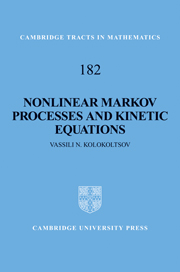Book contents
- Frontmatter
- Contents
- Preface
- Basic definitions, notation and abbreviations
- 1 Introduction
- Part I Tools from Markov process theory
- 2 Probability and analysis
- 3 Probabilistic constructions
- 4 Analytical constructions
- 5 Unbounded coefficients
- Part II Nonlinear Markov processes and semigroups
- Part III Applications to interacting particles
- Appendices
2 - Probability and analysis
from Part I - Tools from Markov process theory
Published online by Cambridge University Press: 05 July 2014
- Frontmatter
- Contents
- Preface
- Basic definitions, notation and abbreviations
- 1 Introduction
- Part I Tools from Markov process theory
- 2 Probability and analysis
- 3 Probabilistic constructions
- 4 Analytical constructions
- 5 Unbounded coefficients
- Part II Nonlinear Markov processes and semigroups
- Part III Applications to interacting particles
- Appendices
Summary
In this chapter we recall some particularly relevant tools from the theory of Markov processes and semigroups, stressing the connection between an analytical description in terms of evolution equations and a probabilistic description. To begin with, we introduce the duality between abstract semigroups and propagators of linear transformations, at the level of generality required for further applications.
Semigroups, propagators and generators
This section collects in a systematic way those tools from functional analysis that are most relevant to random processes; we consider these in the next section. Apart from recalling the notions of operator semigroups and their generators, we shall discuss their nonhomogeneous analogs, i.e. propagators, and use them to deduce a general well-posedness result for a class of nonlinear semigroups. For completeness we first recall the notion of unbounded operators (also fixing some notation), assuming, however, that readers are familiar with such basic definitions for Banach and Hilbert spaces as convergence, bounded linear operators and dual spaces and operators.
A linear operator A on a Banach space B is a linear mapping A: D ↦ B, where D is a subspace of B called the domain of A. We say that the operator A is densely defined if D is dense in B. The operator A is called bounded if the norm ∥A∥ = supx∈D ∥Ax∥/∥x∥ is finite.
- Type
- Chapter
- Information
- Nonlinear Markov Processes and Kinetic Equations , pp. 43 - 72Publisher: Cambridge University PressPrint publication year: 2010



